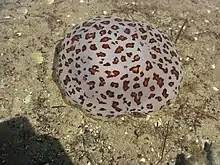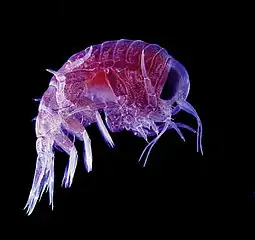Desmonema (cnidarian)
Desmonema is a genus of jellyfish under the Cyaneidae family found in colder waters near the Antarctic region and off of the coast of Argentina.[2][3] They have a bell diameter that can extend over 1 meter and wide tentacles that are grouped together in clusters.[3][4][5] They share similar anatomical and physiological structures to the genus Cyanea.[4] Their sophisticated structures like the thick tentacles, sensory systems, and gastrovascular system allow Desmonema to easily capture and extracellularly digest their prey.[6] In recent years, Desmonema were reported to have a commensal relationship with fishes under the Trachurus genus and a parasitic relationship with specimens of the Hyperia genus.[7][8] The genus name derives from the Ancient Greek desmós (δεσμός), meaning "bond", and nêma (νῆμᾰ), meaning "thread".
| Desmonema | |
|---|---|
 | |
| Desmonema gaudichaudi | |
| Scientific classification | |
| Domain: | Eukaryota |
| Kingdom: | Animalia |
| Phylum: | Cnidaria |
| Class: | Scyphozoa |
| Order: | Semaeostomeae |
| Family: | Cyaneidae |
| Genus: | Desmonema Agassiz 1862[1] |
Anatomy
The anatomical structure of Desmonema closely resembles that of the genus Cyanea.[4] Desmonema tend to have a wider bell diameter between 20 and 100 centimeters compared to other Scyphozoans.[3][4] They have a strong, well-developed radial and circular arrangement of muscles and thick tentacles that are attached in clusters to the base of their bodies.[2][4][6] Similar to their anatomical structures, the gastrovascular system of Desmonema strongly resembles the genus Cyanea.[4] They have 16 radial pouches filled with digestive enzymes that branch off from the stomach to their fluid-filled canals.[2][9] Digestion begins extracellularly and is completed intracellularly.[9] Scyphozoan jellyfish display sophisticated behavior and process environmental information through their advanced neural network.[9] The nervous system works in conjunction with the statocysts, ocelli, and the sensory lappets.[9]
Feeding
Desmonema are able to capture and extracellularly digest their prey, which in turn speeds up their process of digestion.[3][6] For example, squid and fish are larger prey that would need to be reduced to smaller particles for easier and more efficient digestion.[6] The nematocysts on their tentacles and oral arms aid in capturing and digesting larger prey.[3][9] The Desmonema comatum serves as an exception to this rule by feeding on smaller and weaker prey because of their thinner tentacles that would not be able to easily grasp a larger prey.[4] Generally, Desmonema are considered pelagic and benthic predators.[3]
Population distribution
Desmonema are reported to be found near colder regions, specifically towards the Antarctic region. Desmonema gaudichaudi population is commonly found between the Subantarctic Neritic and the Subantarctic Oceanic Domains.[4] Desmonema comatum is found in the Subantarctic region, as well as near the coast of Argentina.[4] Desmonema chierchiana is common in the Falkland Islands in the Subantarctic region.[10]
Life cycle
Falling under the Semaeostome order, Desmonema jellyfish are predicted to follow a metagenetic life cycle.[4] Under this life cycle, a planula larva develops into the deposits of the ocean floor and begins asexually reproducing as a polyp.[11] These sessile polyps are further induced into sexually reproducing medusa by an environmental stimuli.[11] The jellyfish migrate from the deep depths of the ocean to the surface periodically, but tend to be found primarily in deeper waters around 200–3000 meters below sea level.[9][4] More research must be done to fully understand the temporal patterns and life cycle of these jellyfish.[4]
Relationships
_Newport%252C_R_I.jpeg.webp)
Symbiotic
In South Australian waters, Desmonema gaudichaudi exhibited a symbiotic relationship with juvenile fishes identified primarily with the Trachurus genus.[8] The harmful nematocysts of jellyfish make them more appealing hosts for smaller specimen, like fish, crustaceans, helminths, etc.[12]

Parasitic

In Signy Island, South Orkney Island, the first link of a parasitic relationship between Hyperia galba and Desmonema gaudichaudi was recorded by White and Bone in 1972.[5] The Hyperia galba species was found inside of the gastrovascular system and on the subumbrella around the mouth of the jellyfish feeding on its epidermal tissues.[5] The presence of the Amphipoda in the gastrovascular system is vital for their early development when they are released.[5] The degree of parasitism varies between populations, but Hyperia galba has been defined as obligate parasites that alternate between endoparasitic and ectoparasitic during different stages of their life cycle.[5] As young, they reside in the gastrovascular system for development and transition into ectoparasites that feed on the epidermal layer of the jellyfish.[7] In 1973, Bowman identified Hyperia macrocephala on the interior of Desmonema glaciale and they displayed similar parasitic behavior as the Hyperia galba on the Desmonema gaudichaudi.[7]
Species
The following comprises a list of the known Desmonema[13] species:
- Desmonema chierchianum (Vanhöffen 1888)[10]
- Desmonema comatum (Larson 1986)[4]
- Desmonema gaudichaudi (Lesson 1832)[8]
- Desmonema glaciale (Larson 1986)[4]
- Desmonema scoresbyanna (Gershwin & Zeidler 2008)[14]
Cyanea rosea was formerly identified as Desmonema rosea by Agassiz and Mayer in 1898.[8] This species was identified in Largs Bay, South Australia as Desmonema rosea, but its tentacle origin and radial muscle strands on the underside of the jellyfish resembles the genus Cyanea rather than Desmonema.[8] It was later changed by Mayer to Cyanea rosea in 1910.[8]
References
- Larson, R.J. "Biology of the Antarctic Seas 16. Pelagic Scyphomedusae (Scyphozoa: Coronatae and Semaeostomeae) of the Southern Ocean". Antarctic Research Series (1986).
- Bayha, Keith M.; Dawson, MichaelN. (2010). "New Family of Allomorphic Jellyfishes, Drymonematidae (Scyphozoa, Discomedusae), Emphasizes Evolution in the Functional Morphology and Trophic Ecology of Gelatinous Zooplankton". The Biological Bulletin. 219 (3): 249–267. doi:10.1086/bblv219n3p249. ISSN 0006-3185. PMID 21183445. S2CID 25349180.
- Hamner, William M.; Dawson, Michael N (2009). "A review and synthesis on the systematics and evolution of jellyfish blooms: advantageous aggregations and adaptive assemblages". Hydrobiologia. 616 (1): 161–191. doi:10.1007/s10750-008-9620-9. ISSN 0018-8158. S2CID 36276934.
- Schiariti, Agustin Schiariti; Dutto, M. Sofia; Pereyra, Daiana Y.; Failla, Gabriela; Morandini, Andre C. (2018-05-10). "Medusae (Scyphozoa and Cubozoa) from southwestern Atlantic and Subantarctic region (32 60S, 34 70W): species composition, spatial distribution and life history traits". Latin American Journal of Aquatic Research. 46 (2): 240–257. doi:10.3856/vol46-issue2-fulltext-1. ISSN 0718-560X.
- White, M.G.; Bone, D.G. (1972). "The interrelationship of Hyperia galba (Crustacea, Amphipoda) and Desmonema gaudichaudi (Scyphomedusae, Semaeostomae) from the Antarctic". Bulletin Br Antarct Surv. No. 27: 39–49 – via National Environment Research Council.
- Dawson, Michael N; Hamner, William M. (2009). "A character-based analysis of the evolution of jellyfish blooms: adaptation and exaptation". Hydrobiologia. 616 (1): 193–215. doi:10.1007/s10750-008-9591-x. ISSN 0018-8158. S2CID 22168755.
- Larson, R.J.; Harbison, G.R. (1990). "Medusae from Mcmurdo Sound, Ross Sea including the descriptions of two new species, Leuckartiara brownei and Benthocodon hyalinus". Polar Biology. 11 (1). doi:10.1007/bf00236517. ISSN 0722-4060. S2CID 19335199.
- Southcott, R.V. (1987). "The occurrence of Desmonema gaudichaudi (Lesson) (Scyphozoa, Semaeostomea) in South Australian waters with records of fish-jellyfish symbioses". Transactions of the Royal Society of South Australia. 111: 131–132 – via Web of Science.
- Pechenik, Jan A. (16 March 2014). Biology of the invertebrates. ISBN 978-981-4738-61-3. OCLC 951205991.
- Stiasny, Gustav (1934). Scyphomedusae. University Press. OCLC 14074146.
- Suzuki, Kentaro S.; Suzuki, Keita W.; Kumakura, Emi; Sato, Kana; Oe, Yutaro; Sato, Tasuku; Sawada, Hideki; Masuda, Reiji; Nogata, Yasuyuki (2019-11-21). "Seasonal alternation of the ontogenetic development of the moon jellyfish Aurelia coerulea in Maizuru Bay, Japan". PLOS ONE. 14 (11): e0225513. Bibcode:2019PLoSO..1425513S. doi:10.1371/journal.pone.0225513. ISSN 1932-6203. PMC 6872181. PMID 31751435.
- Kondo, Yusuke (2014). "Associations of fish juveniles with rhizostome jellyfishes in the Philippines, with taxonomic remarks on a commercially harvested species in Carigara Bay, Leyte Island". Plankton & Benthos Research. 9: 51–56. doi:10.3800/pbr.9.51. ProQuest 1618955957 – via ProQuest.
- Larson, R.J. (1986). "Biology of the Antarctic Seas 16. Pelagic Scyphomedusae (Scyphozoa: Coronatae and Semaeostomeae) of the Southern Ocean". Antarctic Research Series. 41: 59–165. doi:10.1029/AR041p0059 – via Web of Science.
- Gómez Daglio, Liza; Dawson, Michael N (2019). "Integrative taxonomy: ghosts of past, present and future". Journal of the Marine Biological Association of the United Kingdom. 99 (6): 1237–1246. doi:10.1017/S0025315419000201. ISSN 0025-3154. S2CID 150316119.